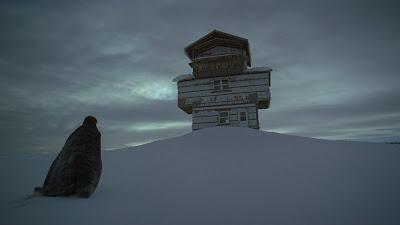Format: DVD from Sycamore Public Library on basement television.

There are a number of topics that split the average horror movie fans. Gore, for instance, is loved by some and shunned by others who look for a more cerebral horror (and of course there are those who accept it when it’s needed). Another is the concept of the slow burn film. Horror that is going for the quick thrill doesn’t do a lot of slow burn. It’s about showing the audience a terrible spectacle. The slow burn is often about the idea of creating something much deeper than mere shock or disgust. The slow burn is about the build of terror and, hopefully, a payoff of something truly terrifying, a lasting scare that seeps into the audience’s bones. That’s definitely the goal with The Lodge.
The Lodge very much plays with an idea I heard Wes Craven bring up in an interview about Scream. According to Craven, if you give the audience a good scare in the first 15 minutes, you don’t really have to scare them again until the end. The film opens with our introduction to Richard Hall (Richard Armitage) and his two children, Aiden (Jaeden Martell) and Mia (Lia McHugh). The kids are going through the “separated parents trade-off” and Richard tells his estranged wife Laura (Alicia Silverstone) that he wants to finalize the divorce because he is going to marry Grace (Riley Keough), someone he met while researching his latest book. Laura takes that news poorly; she goes home and shoots herself through the mouth.
Six months later, it’s Christmas time, and Richard has struggled with getting his children to spend any time around Grace. He tells them that they are going to spend Christmas at their isolated cabin, and because of his work, they will be spending a couple of days alone with Grace. The hope on her part is that they will get to know her a little. The kids are resistant, but the don’t have much choice in the matter.
What we’ve also learned is that Richard’s research that led him to Grace is into a cult that committed mass suicide. Grace, who was the daughter of the cult leader, was the only survivor. The cult members were found on their beds under purple silk robes with duct tape across their mouths, “SIN” written on the tape. At the cabin, the kids are initially aggressive toward Grace, but when Richard is forced to leave, the kids are left with Grace as their only adult supervisor. For her part, Grace appears to be deeply unsettled by the large amount of religious, specifically Catholic, imagery around the house—there’s enough of it that she starts having nightmares about her father.
The turn happens one night when Grace and the kids watch a movie. With a storm brewing outside, the kids decide to turn on a gas heater, which they tell Grace is completely safe. However, the next morning, Grace wakes up to find everything of hers missing—her clothing, her dog, and her psychiatric medication. Worse, they watched the movie on December 22 but all of the calendars around the house say January 9. She is convinced initially that the kids are playing a joke on her that has gone too far, but Aiden tells her he has dreamed that the gas heater malfunctioned, suffocating them all, and all three of them are in purgatory.
Over the next few days, Grace deals with withdrawal from her medication, and with the possibility that she and the kids are dead. She leaves the house to find help, but eventually returns to the cabin after finding a different cabin where she sees her dead father. In the snow, she finds a picture of the kids in an “In Memoriam” frame, and inside, the kids are readying a newspaper article about their deaths from carbon monoxide poisoning. And from here, there will be more and more disturbing proofs of whether or not they are actually dead and in some terrible afterlife.
Honestly, religious trauma seems to be a fertile field not merely for movies in general but for horror movies in the specific. There is always an element of horror in religion, at least in anything beyond the sort of hippy-dippy feel-good stuff that seems to be pretty common with a lot of people. Most religions have a significant component of blood, sacrifice, and pain. This is precisely what The Lodge plays on. It moves very slowly getting us there, and this is incredibly effective. The slow realization of religious trauma starting to come true is something that does need to build over time to be effective. The audience has to buy in, and if it works, it ends up being incredibly effective. It's honestly a little surprising this was from 2019. It feels like a movie that is heavily influenced by COVID. This is all about the isolation and the slow build of insanity caused by it. It’s the most effective part of the film, and appears to be serendipity in terms of how it would affect public consciousness on watching the film. I can only imagine this was even more intense in the months after its release.
Why to watch The Lodge: It almost feels prescient of COVID-19.
Why not to watch: It is the slowest of slow burns.
